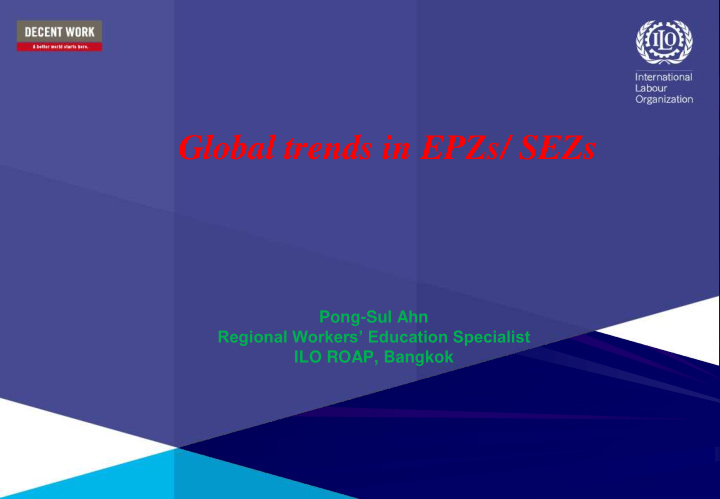



Global trends in EPZs/ SEZs Pong-Sul Ahn Regional Workers’ Education Specialist ILO ROAP, Bangkok
Key constitutive elements of an EPZ With special incentives Relatively small, geographically separated areas To attract export-oriented industries with free trade conditions and a liberal regulatory framework Limitation on trade union rights
ILO estimates on employment in EPZs Geographical area Estimated number of Number of zones workers Asia 55,741,147 900+ Central America and 5,252,216 155 Mexico Middle East 1,043,597 50 North Africa 643,152 65 Sub-Saharan Africa 860,474 90+ United States 340,000 713 South America 459,825 43 Transition economies 1,400,379 400 Caribbean region 546,513 250 Indian Ocean 182,712 1 Europe 364,818 50 Pacific 145,930 14 TOTAL (estimations) 65,980,763 3500+ ILO: Trade union policy guide on EPZs (Geneva, 2015), p.10.
ILO estimates of employment trends in EPZs (2008) 1975 1986 1995 1997 2002 2006 Number of 29 47 73 93 116 130 countries with EPZs Number of EPZs 79 176 500 845 3000 3500 Employment n/a n/a n/a 22.5 43 66 (millions) -China n/a n/a n/a 18 30 40 -Other countries 0.8 1.9 N.A 4.5 13 26 ILO: Trade union policy guide on EPZs (Geneva, 2015), p.10.
Info on investing countries, sectors and export markets: Country Main investing Main sectors Main markets countries Singapore Japan, US, Food processing, US, ASEAN Mexico, Canada, textiles, chemicals, countries, Gulf Chile, Australia, electronics States, European New Zealand, etc components, etc Union, etc Malaysia Japan, UK, High-tech, food Japan, US, Germany, Italy, processing, Germany, Republic Finland, Taiwan, pharmaceuticals, etc of Korea, etc Switzerland, etc Thailand EU, US, Taiwan, Agricultural Republic of Korea, Singapore, etc products, minerals The Netherlands, and ceramics, Austria, Malaysia, plastic, electronics, Japan, India, US, etc etc ILO: Trade union policy guide on EPZs (Geneva, 2015), p.14.
Why do governments create EPZs? • Job creation and improved living standards • Transfer of skills and expertise to local human resources • Introduce new technology • Boost the export sectors • Foreign exchange earning • Creation of backward and forward economic linkages
Why do enterprises invest in EPZs? • Various incentives • Availability of affluent human resources • Strategic location close to markets • Quality of the infrastructure, including supply of raw materials • Benefits from trade agreements • Labour relations environment, including low labour costs
Sample of range of tax incentives for EPZs Donella Caspersz: Organizing Export Processing Zone Workers (Univ. of Western Australia)
Key challenges • Total bars on unionization • To replace unions with other types of workers’ organisations • Restrict union leaders to have access to EPZs • Limitations on collective bargaining • Limitations on strikes • Inadequate protections against anti-union discrimination • Gender-based discrimination
Union strategies • Social dialogue, involving - the state - the employers - society • Organising and collective bargaining
• Advocacy - legal advocacy - media advocacy • Campaigns - petitions - distributing fliers and information sheets - public meetings - demonstrations - street theatre - online media mobilisation
Thank You
Recommend
More recommend